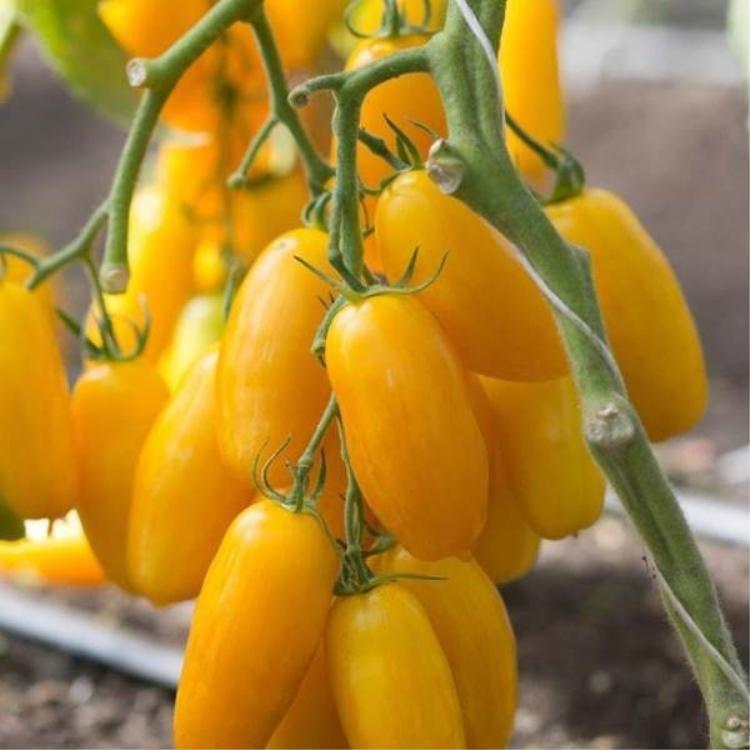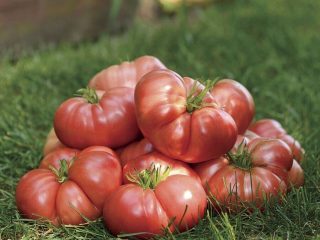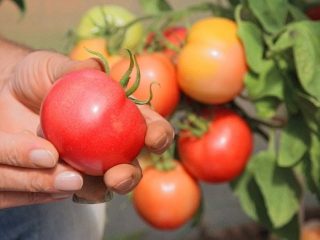Content
There are many varieties of tomatoes with unusual shapes and colors. One of these varieties is the Yellow Banana tomato. Gardeners with extensive experience are already actively growing this unique variety on their plots.

The Yellow Banana variety is interesting in the shape of its fruits, reminiscent of a well-known fruit
History of selection
The tomato variety Banana Yellow was bred by a group of talented agronomists consisting of N. N. Klimenko, A. N. Kostenko, A. N. Khovrin and T. A. Tereshkova. In 2015, the State Commission of the Russian Federation included it in the register of plants approved for cultivation in film and glazed greenhouses. The tomato is not a hybrid.
Description and characteristics of banana yellow tomatoes
Judging by the photo and description, the yellow Banana tomato has original external features:
- The plant is heavily leafy and indeterminate. In the absence of proper care, it instantly grows, which negatively affects the yield and taste of the fruit.
- Yellow Banana tomato bushes are not standard.They are vigorous, up to 2.5-3 meters high.
- The root system develops well in breadth and reaches more than 50 cm.
- The stems are strong, but need to be tied to a support, since they can become deformed under the weight of their fruits.
- The leaves are beautiful, openwork, light green in color. The surface of the plates is smooth, wrinkled, and medium in size.
- Flower brushes are simple, intermediate, located every two leaves.
- Tomatoes are elongated, plum-shaped, up to 7 cm long and weighing 100-120 g. Ripe fruits are yellow, unripe fruits are light green, without a spot at the stalk. The pulp is dense and juicy. The taste of the fruit is sweet, with a slight sourness.

The skin is thin, but the tomatoes are resistant to cracking
When it ripens
If agricultural practices are followed, flowering occurs in early or mid-June. Tomato variety Banana yellow mid-season. Tomatoes ripen almost simultaneously in 105-110 days. They are harvested at the end of August or beginning of September.
Tomato yield Banana yellow
The tomato variety is characterized by average yield, but stable fruiting. Several large fruits are formed in each cluster. Gardeners harvest from 3 to 5 kg of tomatoes from one bush every season.

In order not only to preserve, but also to increase the harvest, it is recommended to shape and plant tomatoes of the Banana variety.
Resistance to adverse factors
The variety is weakly resistant to unfavorable factors. In cold and rainy weather, tomatoes do not have time to ripen on time.Gardeners have to pick them from the bushes when they are green and ripen them at home. For this reason, it is recommended to grow tomatoes in greenhouses. However, residents of the southern regions successfully grow them in open ground.
Growing regions
The Yellow Banana variety is zoned in the following regions:
- Northern;
- North-West;
- Central;
- Volgo-Vyatka;
- North Caucasus;
- Srednevolzhsky;
- Nizhnevolzhsky;
- Ural;
- West Siberian and East Siberian;
- Far Eastern.

In the conditions of the middle zone and cold regions, this variety is not grown in open ground, only in greenhouses
Purpose and application
Yellow Banana tomatoes are used for salads, and they are mainly used for preparing bright summer salads. They are good in combination with herbs and other vegetables. In addition, the fruits can be used to make juice by combining with red juicy tomatoes. The result is a drink with a beautiful orange color.
Advantages and disadvantages
The yellow fruits of the Banana variety have a marketable appearance. They do not fall off the bush on their own and do not burst. Thanks to this property, they are suitable for long-term transportation for commercial purposes.

Due to their elongated shape, tomatoes are easy to cut
Advantages:
- stable fruiting;
- resistance to viral tobacco mosaic and pests;
- interesting appearance;
- balanced taste and bright aroma;
- amicable maturation;
- Allergy sufferers and children are allowed;
- good keeping quality;
- possibility of ripening.
Flaws:
- bushes need to be shaped and pinched;
- The growth of bushes must be limited.
When and how to plant
Yellow Banana tomatoes are grown in seedlings in greenhouse conditions. Sowing is carried out in mid-March or late February.The seeds are sown in a container, covered with film or transparent glass and placed on a light windowsill. As soon as 3-4 true leaves appear on the seedlings, they are dived into separate cups. In April-May, the plants are transferred to the greenhouse.
Planting pattern:
- The selected area is divided into beds. Form holes, trying to adhere to the 40 by 60 pattern, and water generously.
- The seedlings are carefully removed from the containers and placed in the holes.
- The earth is compacted by hand and mulched with cut grass or sawdust.
After planting, young tomatoes try not to be disturbed, allowing them to adapt and take root in a new place. The variety loves loose, fertile and well-drained soil. The soil must be filled with organic and mineral fertilizers. When digging, you can add rotted manure, compost and a little wood ash to normalize the acidity, which should be in the range of 6.2-6.8 pH. In favorable soil conditions, tomato bushes easily take root, build up the root system and begin to grow.
However, simply planting tomatoes in the ground is not enough. In addition, you need to know the specifics of caring for the crop.
Features of care
Bushes need to be formed weekly. If you do not do this, then many stepsons will appear on the tomatoes, which will thicken and shade the bushes. As a result of inadequate ventilation of the crown, various diseases will occur. To avoid negative consequences, you need to tear off all side shoots and pinch the tops of the bushes when they reach their maximum height.
Watering should be done once a week, provided that the tomatoes are growing in a greenhouse.In the south of the country, the variety can grow in open ground, then the tomatoes will need more frequent watering.
Systematic feeding of tomato bushes will help you enjoy the sweet fruits. About once a month you need to add any liquid complex mineral fertilizer to the water for irrigation.

During planting, a teaspoon of urea and superphosphate is placed in the holes.
Prevention of diseases and pests
Prolonged rains and poor ventilation in the greenhouse lead to the development of root rot and various fungal diseases of tomato. For the purpose of prevention, it is necessary to regularly treat the bushes with Bordeaux mixture or other fungicidal agents.
Tomatoes kept in a greenhouse are usually not bothered by pests. But for prevention, it is sometimes worth spraying them with a soap solution. When bushes grow in open ground, they are often damaged by aphids, thrips, whiteflies, spider mites and the Colorado potato beetle. At the first signs of insect activity, it is necessary to take measures to combat them.

The complex drug Actellik helps to quickly destroy whiteflies.
Conclusion
The Yellow Banana tomato is a new variety, but already in demand among gardeners. It attracts attention not only with its interesting shape, but also with its characteristics. The variety is mainly grown in greenhouses, but in favorable conditions it grows without problems in open ground. Familiarizing yourself with it in detail will help you avoid mistakes in growing.
Reviews from gardeners about Yellow Banana tomatoes











